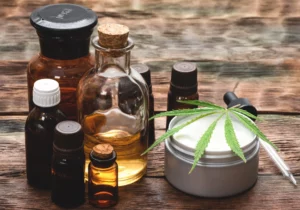The concepts “runner’s high” and “second wind” are familiar to serious athletes. They’re examples of the way intense exertion can bring on a feeling of energy, euphoria and complete union of body and mind. Now, recent research reveals that the positive benefits of exercise arise from the body’s endocannabinoid system—and that for athletes of all kinds, cannabis can help to boost performance, relieve pain, and protect cells and neurons from damage and death.
FOLLOW US ON FACEBOOK & INSTAGRAM
Cannabinoids, not Endorphins Responsible for Workout High
A large and growing body of research continues to show that working out—or just moving more—has the power to alleviate aches and pains, reduce anxiety, improve concentration and even ease the symptoms of depression. Those benefits are so well documented that exercise is often prescribed as part of a recovery plan for both physical and mental health conditions.
For years, sports medicine researchers worked hard to pin down the reasons behind those well-documented effects of exercise. Until relatively recently, though, it was generally believed that the positive effects of exercise came from the release of endorphins—“feel good” chemicals expressed by the body’s own natural system of opioid receptors during intense, focused physical activity.
Because higher levels of endorphins can be measured in the blood under those conditions, researchers believed that these natural opioids were responsible for the runner’s high and other mood-altering benefits of exercise. The opioid receptor system is largely concentrated in the brain and is strongly associated with the pleasure-reward-learning circuit. Opioid receptors, especially in the brainstem, also activate to block pain signals.
But newer research raises questions around this theory. In 2004, British sports medicine researchers observed that the mood-altering aspects of intense physical activity more closely resembled the effects reported by recreational marijuana users than the sedating effects of opioids.
Sports and intense exercise, they discovered, stimulate the expression of natural cannabinoids in areas of the brain related to pleasure, concentration and pain relief. But because cannabinoid receptors are notably lacking in the brainstem and gastrointestinal tract, cannabinoids don’t cause the sedative effects and gastric slowdown typical of opioids.
What’s more, endorphins in the bloodstream aren’t able to pass the blood-brain barrier.
But cannabinoids can, and when they activate receptors in the body’s endocannabinoid system, they produce the peak experiences and pain
relief known to athletes and marijuana consumers alike. Whether generated by the body itself or consumed from external sources such as cannabis, cannabinoids can also exert a protective effect potent enough to slow the progression of a number of neurological conditions—and prevent the death of neurons after events such as traumatic brain injury.
RELATED: WHAT IS THE ENDOCANNABINOID SYSTEM?
The Endocannabinoid System Generates Positive Effects During Exercise
The endocannabinoid system is a wide-ranging natural network of cannabinoid receptors that affect virtually all functions throughout the body. But this system wasn’t discovered until the 1980s, and much remains to be learned about its many complex functions, including its differences from the opioid receptor system. Those differences help to explain why cannabinoids are more able to produce the positive effects associated with exercise than opioids, and why cannabis can have more far-reaching effects on the body as a whole.
The endocannabinoid system includes two kinds of receptors. CB1 is abundant in many areas of the brain, the central and peripheral nervous systems, and organs and tissues throughout the body. In the brain, CB1 receptors exist alongside opioid receptors in areas related to pleasure, relaxation and pain responses—but they’re virtually absent in the brainstem, where opioid receptors are plentiful. CB2 is more closely associated with peripheral tissues and the immune system.
The human body produces two natural cannabinoids, anandamide and 2AG, which bind to these receptors, triggering a range of responses and supporting the functioning of other kinds of systems. The most abundant compounds in cannabis, tetrahydrocannabinol (THC) and cannabidiol (CBD), are so similar to these natural cannabinoids that they can activate the receptors in the same way.
Cannabinoids Provide Athletes With Neuroprotection, Pain Relief & More
Because cannabinoid receptors are found on all kinds of cells throughout the body, they play an important role in protecting neurons from damage caused by inflammation, oxidation and various disease processes. This explains why cannabis can slow the progression of diseases such as multiple sclerosis and Parkinson’s disease and prevent neuron
death after injuries—even traumatic brain injury, a major risk in contact sports such as football.
Cannabinoids can relieve pain—better than opioids, according to many users. During exercise, activation of cannabinoid receptors in the brain and tissues can help athletes to push past the pain or not feel it at all. During recovery, too, cannabis products of all kinds can help reduce inflammation in muscles and tissues, and help manage pain from sports-related injuries.
Cannabinoids also support the healthy functioning of many essential processes in the body, and during exercise they can promote the oxygenation of tissues by encouraging vasodilation and bronchodilation for better blood flow and respiration. Increased oxygenation can enhance endurance and focus during intense exercise and competitive sports.
Marijuana & Sports: A New Relationship
Athletes have been using cannabis for a long time, though many have been reluctant to say so openly. Now, cannabis entrepreneurs and activists, along with athletes in sports ranging from martial arts to football, are working to promote the use of cannabis products.
VapeXhale founder Seibo Shen is a jiujitsu fighter and passionate advocate of cannabis consumption to “activate” performance in sports of all kinds. As cofounder of CannAthlete, Seibo works with athletes in a structured program that combines cannabis with other mind-body techniques.
Cannabis, he says, “tends to facilitate a state of homeostasis. Being relaxed and also able to dynamically spring into action—that’s the mind state we want athletes to be in.”
Cannabis activist and entrepreneur Jim McAlpine is also working to shatter the myth of the “stoner” and show that cannabis can be a key part of an active lifestyle. As founder of the 420 Games, a series of athletic events promoting the healthy and responsible use of cannabis, Jim points out that many world-class athletes and champions have used cannabis—and that it can help, not hurt, performance.
A growing body of research reveals that cannabis works with the endocannabinoid system to provide its benefits—and along with the well-known “high,” athletes across the spectrum of sports can use it for performance, pain relief and protection.
Photo credit: Autumn Goodman
If you’re new to cannabis and want to learn more, take a look at our Cannabis 101 post. HelloMD can help you get your medical marijuana recommendation; it’s easy, private and 100% online.






